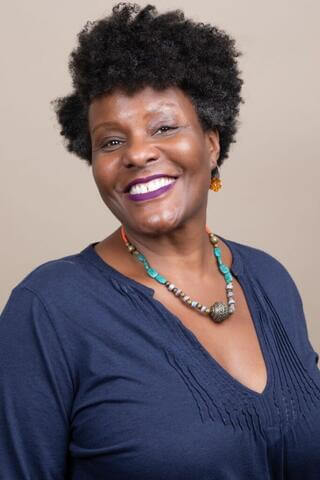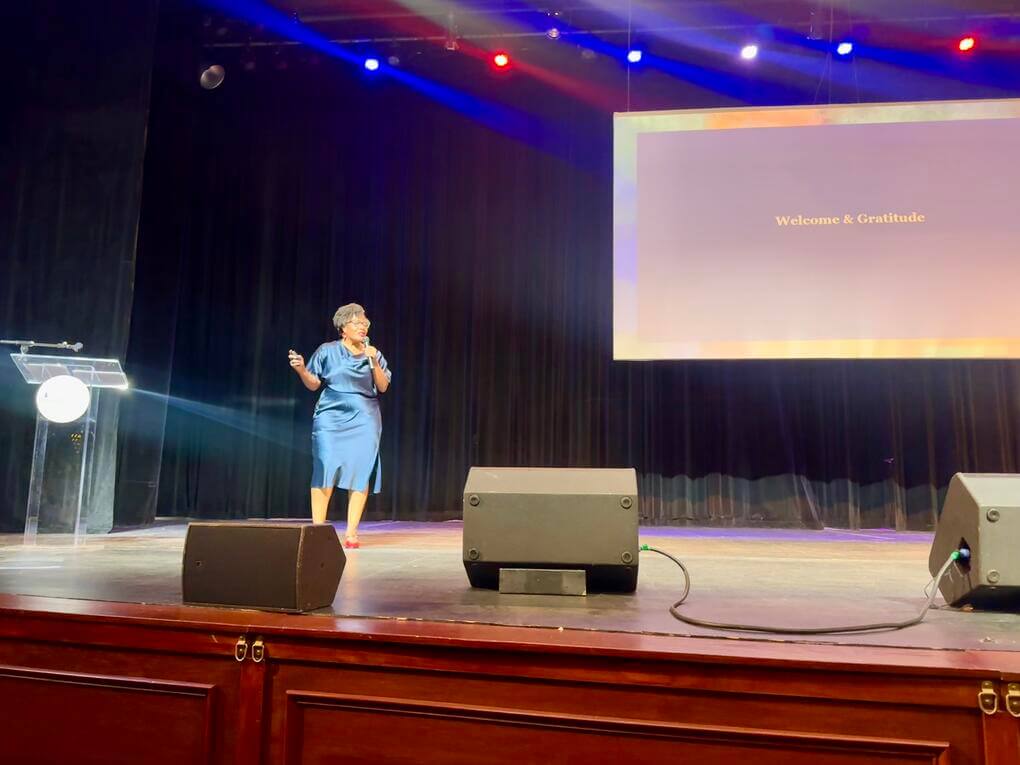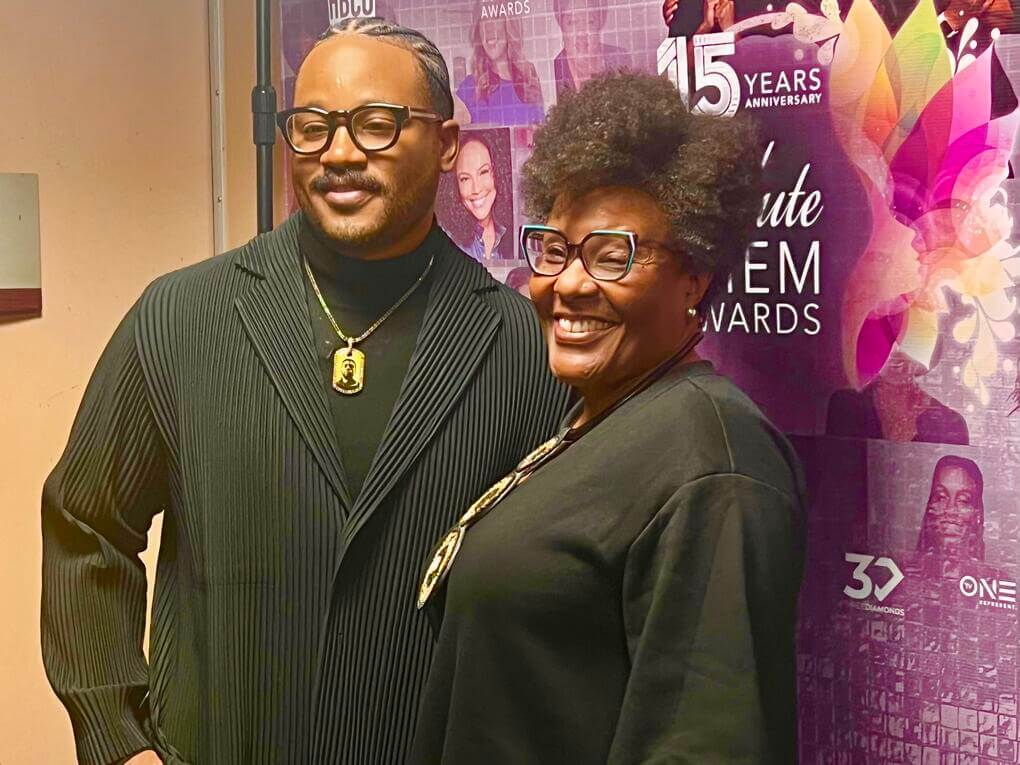Lighting the Torch Forward: Dean Raquel Monroe Reflects on Her First 100 Days

At noon on Thursday, November 13, the Chadwick A. Boseman College of Fine Arts gathered in Cramton Auditorium to mark a milestone in its young but storied re-establishment. Faculty with decades-long roots at Howard sat alongside students born long after the College’s original heyday, all drawn into the auditorium by a shared anticipation: hearing Dean Raquel Monroe reflect on her first 100 days and chart a vision for what comes next.
Before the Dean took the stage, Assistant Dean for Administration Denise Saunders Thompson offered a sweeping, reflective introduction that framed the moment not merely as a leadership benchmark, but as an inflection point in the College’s evolution. Speaking with the authority of someone who has spent more than thirty years at Howard—first as a student, then faculty member, administrator, and now second-generation alumna—she acknowledged both the remarkable continuity and the overdue transformation unfolding within the College.
She began by situating the audience in a period of profound institutional change. “Change is never easy,” she reminded the room, “and institutional change can be particularly challenging.” Yet this moment, she insisted, demands not just adaptation but “a fundamental transformation of who we are and how we operate.”
In a gesture that blended history, spirituality, and cultural lineage, Saunders Thompson invoked the symbolism of the number three from African spiritual traditions—creativity, evolution, gateways, truth-telling—and drew a parallel between these meanings and Monroe herself. The new Dean, she said, embodies “voice, writing, and movement”—not as abstractions, but as pillars of a career grounded in Black feminist performance praxis, scholarship across influential journals, and internationally performed choreography and installation work.
She recounted Monroe’s administrative impact at the University of Texas at Austin, where she managed a $9.1 million budget and launched grant initiatives that seeded interdisciplinary work across dozens of programs. She described Monroe’s years at Columbia College Chicago, where she rewrote hiring and tenure policies to embed equity at the structural level, leading to a measurable increase in faculty diversity. And she underscored Monroe’s record as a strategist who marries resource stewardship with cultural impact, citing initiatives that supported faculty wellness, cross-disciplinary community building, and external grant success from organizations like the Mellon Foundation and the National Endowments for the Arts and Humanities.
But above all, Saunders Thompson emphasized urgency. The College, she said, is operating in a landscape that is rapidly shifting, where long-standing practices “may no longer be sufficient” to sustain future success. She invited the audience to imagine what the College could become—streamlined, collaborative, empowered—and argued that Monroe’s leadership represents not only direction, but alignment, discipline, and a chance to build systems worthy of the institution’s ambitions.
It was a fitting prelude to a day centered on evolution—past, present, and future. Then, as she invited the crowd to rise, the auditorium erupted into a standing ovation as Dean Raquel Monroe stepped into her light.
Grounded in Gratitude
When Dean Monroe began her address, she framed the moment with thanks. She honored the women and mentors who shaped her, the colleagues who steadied the College through transition, and the leaders across the University who have been crucial to her early success. She acknowledged Interim Dean Dr. Gwendolyn Everett “for her vision and grace,” saluted A.D. Saunders Thompson for serving three deans with “steadfast leadership and institutional wisdom,” and thanked the Provost and fellow deans for their mentorship and courage. She also recognized alumni “who lit the torch we now carry forward,” expanding the frame from a 100-day address to a generational relay.
Students at the Center
Monroe’s first major focus was the community that animates her leadership: the students. “You are worth it,” she told them, a simple statement that echoed throughout the rest of her remarks. She shared that after two decades in the classroom, this year is her first without teaching, and she “felt the loss.” Teaching, she explained, grounds her in the cyclical exchange of learning.
Her intention to return to classrooms is deliberate. Students keep her attuned to emerging creativity — fashion, technology, cultural shifts — and it is their imagination that should shape the future of the College’s curriculum. “The torch that illuminates the path for Black art and scholarship,” she reminded them, “shines through the African Diaspora.” If Howard students are to imagine the futures that Ryan Coogler envisions in film — and that Chadwick Boseman embodied on screen — the curriculum must evolve alongside them.
A Curriculum Rooted in the African Diaspora
The core of Monroe’s address centered on reimagining curriculum as a living archive of the Diaspora. She invoked alumna Bisa Butler, whose quilt-making merges ancestral practice with contemporary voice, as emblematic of the fusion she hopes to nurture. She also championed faculty whose classrooms function as sites of cultural excavation and innovation.
She then outlined three areas of curricular expansion:
1. Hip Hop as Scholarship
Hip Hop is a multi-layered, disciplined practice worthy of academic inquiry. Monroe announced a proposal for a major in Hip Hop Studies and a minor in Interdisciplinary Studies, rooted in the five pillars of the culture: dance, DJing, MCing, graffiti arts, fashion, and knowledge. Howard, she noted, enters this terrain with lineage — Chadwick Boseman himself wrote the hip-hop theatre works Rhyme Deferred and Deep Azure.
2. Improvisation as Black Life
Improvisation does not belong solely to jazz; it is foundational to Black lived experience and survival. Monroe encouraged the College to cultivate more interdisciplinary spaces for improvisation — through workshops with comedians, dancers, and multidisciplinary artists, and through teaching practices that honor Diasporic traditions across the Caribbean, Africa, and Afro-Latin America.
3. Technology and the Future of Creativity
“AI is here — and of course we’re embracing it,” she said, generating knowing murmurs from students. The College’s integration of technology through The DOC, motion capture exploration, and faculty-led innovation in theatre, dance, and design reflects a commitment to using tools that “enhance our humanity, not replace it.”
The future is not a choice between technology and creativity. It is a commitment to use technology to amplify creativity.
Preparing Students for Creative Economies
Monroe stressed that creative excellence must be paired with economic empowerment. The College is expanding internships, experiential learning, and arts management training so students “don’t just create art, but shape industry.” Career development, she emphasized, must be embedded within every discipline.
She then highlighted several initiatives shaping the College’s next era:
BADGE: Black Arts, Design, and Global Engagement
The BADGE Center is becoming a global hub for dialogue across the Diaspora. Its spring lecture series will open with Dean Onye P. Ozuzu (University of Florida College of the Arts), whose research merges dance and architecture through embodied technology.
Other initiatives include:
- The proposed Hip Hop major
- An Arts, Health, and Well-being program inspired by Taraji P. Henson’s mental health advocacy
- Expanded teaching certification pathways
- A professional workshop series that brings industry experts directly to students
Building Spaces Worthy of the Work
Turning toward infrastructure, Monroe invited the community to “vision with me.” She outlined plans to upgrade studios, sound recording spaces, and chorale rooms; to build three new dance studios; to expand facilities for Fashion Studies; and to invest in state-of-the-art recording equipment for musicians and visual artists.
To support this vision, she announced the creation of a $5 million Living Legacy Endowment for student scholarships, with a near-term goal of raising the first $100,000. She also positioned Bison at Basel 2025 as a major experiential platform where students can learn, exhibit work, and shine on a global stage.
Telling Our Story
As she closed, Monroe shifted from facilities to narrative. “None of this matters if we don’t share our story,” she said. She credited the College’s inaugural Director of Marketing and Communications, Chad Eric Smith, for helping transform its communications ecosystem and underscored the importance of visibility, storytelling, and shared voice.
She invited the community to stay connected across social platforms and to participate actively in shaping the College’s next chapter.


